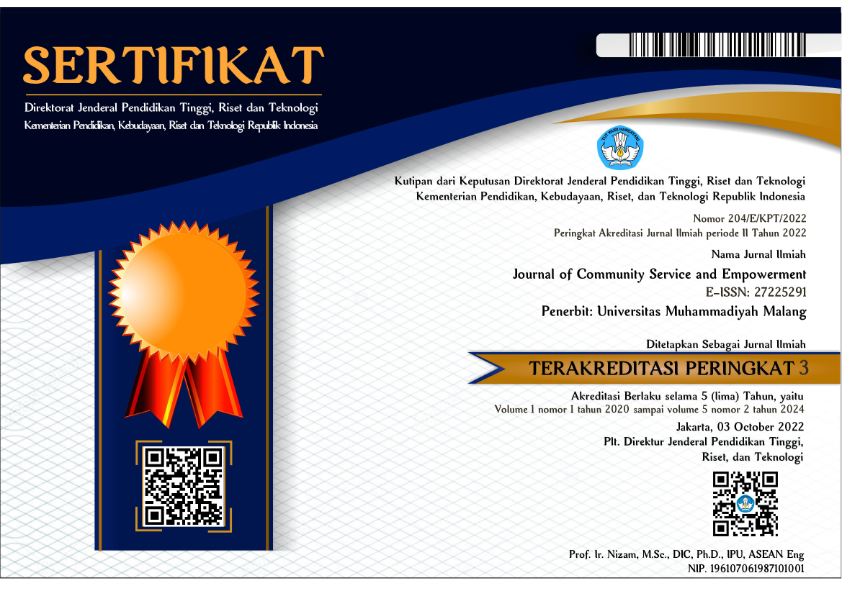The strength of Muhammadiyah's existence in the modern era: Pillars of empowerment and community strengthening
DOI:
https://doi.org/10.22219/jcse.v5i2.33085Keywords:
community strengthening, empowerment, Muhammadiyah, philanthropyAbstract
A study regarding the role of Muhammadiyah in the pillars of community empowerment and strengthening needs to be carried out, considering that this organization is the largest organization in Indonesia. This article aimed to analyze the strength of Muhammadiyah's existence which focuses on the pillars of empowerment and strengthening of society. This paper was prepared using library research methods. Data were analyzed using qualitative descriptive analysis. Data visualization, especially regarding references and keywords that frequently appear, is assisted with VOSviewer. The results show that Muhammadiyah is an Islamic organization that has a clear and real role in empowering and strengthening of society. Muhammadiyah has a central role in the field of philanthropy, in fact this has become Muhammadiyah's identity. Al-Ma'un became the ideological-theological foundation of Muhammadiyah's struggle. The advocacy movement through community empowerment has changed the face of Muhammadiyah to become more populist. Community empowerment is carried out through action programs that directly touch on the real problems of poor and marginalized communities represented by farmers, fishermen, livestock breeders, workers, urban poor communities and people with disabilities. Women's groups who have been marginalized and tend to be subordinated have also become targets of empowerment work carried out by Muhammadiyah, especially through its wing organization, namely Aisyiyah.
Downloads
References
Alfaris, A. (2022). Kontribusi penanganan bencana Covid-19 oleh Muhammadiyah Disaster Management Center di Indonesia. Sang Pencerah: Jurnal Ilmiah Universitas Muhammadiyah Buton, 8(1), 14–27. https://doi.org/10.35326/pencerah.v8i1.1841
Aprillianti, R., Safira Bella Avilia, D., & Romelah, R. (2022). The role of Muhammadiyah Islamic movement in hacking a new map of local culture in Indonesia. Audito Comparative Law Journal (ACLJ), 3(1), 10–17. https://doi.org/10.22219/aclj.v3i1.19857
Ardianto, A. (2020). Kontribusi Lazismu terhadap SDGs - Muhammadiyah. Muhammadiyah. https://muhammadiyah.or.id/2020/12/kontribusi-lazismu-terhadap-sdgs/
Bakry, K., Asse, A., Syamsuddin, D., Salenda, K., & Shaari, R. (2021). Political dynamics of Muhammadiyah and its relevance to the concept of the state in Islam. Al-’Adalah, 17(2), 383–396. https://doi.org/10.24042/adalah.v17i2.6824
Buletin Sleman. (2023). Hari Anak Nasional, Aisyiyah DIY serukan perlindungan untuk anak. Buletin Sleman. https://buletinsleman.com/2023/07/24/hari-anak-nasional-aisyiyah-diy-serukan-perlindungan-untuk-anak/
Echo, P. (2023). Sesuai SDG’s, Ini fokus gerakan Muhammadiyah lima tahun ke depan. Universitas Muhammadiyah Kotabumi. https://www.umko.ac.id/2023/02/06/sesuai-sdgs-ini-fokus-gerakan-muhammadiyah-lima-tahun-ke-depan/
Elihami, E. (2022). Describing about ‘Teachers and Kemuhammadiyahan’ in elementary school department: A review of literature. Mahaguru: Jurnal Pendidikan Guru Sekolah Dasar, 3(1), 42–54.
Ferihana, F. (2022). Perkembangan amal usaha Muhammadiyah di bidang pendidikan dan kesehatan. Jurnal Studi Islam Dan Kemuhammadiyahan (JASIKA), 2(2), 156–164. https://doi.org/10.18196/jasika.v2i2.31
Hakim, I., & Muslikhati, M. (2022). Model gerakan ekonomi Muhammadiyah pasca muktamar ke 47 Muhammadiyah’s Economic Movement Model Post-47th Congress. Jurnal Sinar Manajemn, 09, 325–334.
Hamami, T. (2021). Muhammadiyah and Nahdlatul Ulama education: Two main pillars of national education in Indonesia. Jurnal Pendidikan Agama Islam, 18(2), 307–330. https://doi.org/10.14421/jpai.2021.182-06
Ilyas, I. (2016). Pendidikan karakter melalui homeschooling. Journal of Nonformal Education, 2(1), 93–98. https://doi.org/10.15294/jne.v2i1.5316
Karsiman, K., & Eddyanto, E. (2018). Peran Muhammadiyah dalam pemberdayaan masyarakat Kokoda di Kota Sorong. Jurnal Noken, 4(1), 23–33.
Khoiruddin, A. (2019). Muhammadiyah and community development programs : Habitus, modality, and arena. Dialog, 42(2), 163–182.
Lestari, D. P., & Fauzi, A. M. (2022). Muhammadiyah’s contribution to education in indonesia and its influence on people’s social life. Proceedings of the International Joint Conference on Arts and Humanities 2021 (IJCAH 2021), 618(Ijcah), 833–836. https://doi.org/10.2991/assehr.k.211223.144
Miles, M. B., Huberman, A. C., & Saldana, J. (2019). Qualitative data analysis. SAGE Publications, Inc. https://us.sagepub.com/en-us/nam/qualitative-data-analysis/book246128#contents
Muhammadiyah, S. M. P., & Kabupaten, N. (2024). Muhammadiyah ’ s contribution to educational development in Indonesia : A historical analysis. 4(1), 43–50.
Nashir, H. (2015). Muhammadiyah a reform movement (Vol. 53, Issue 9). Universitas Muhammadiyah Surakarta.
Panti Asuhan Muhammadiyah Magetan. (2020). Sekilas tentang kami _ Panti Asuhan Muhammadiyah Magetan. Panti Asuhan Muhammadiyah Magetan. https://pantiasuhanmuhammadiyahmagetan.com/2020/10/30/sekilas-tentang-kami/
Ramadhan, A. N. F. (2022). Transformation of Tafsir At-Tanwir audiovisual on youtube in the verse of ummatan wasatha. QiST: Journal of Quran and Tafseer Studies, 1(2), 163–182. https://doi.org/10.23917/qist.v1i2.747
Rohana, R. (2018). Dakwah Muhammadiyah melalui optimalisasi peran perempuan dalam dakwah Aisyiyah. Jurnal Bimas Islam, 11(2), 301–324.
Sari, M., & Asmendri, A. (2020). Penelitian kepustakaan (library research) dalam penelitian pendidikan IPA. NATURAL SCIENCE: Jurnal Penelitian Bidang IPA Dan Pendidikan IPA, 6(1), 41–53.
Setyawan, D. (2017). Moving ijtihad and tajdid on amal usaha Muhammadiyah (AUM) in building the civilization of islamic economy. Addin, 11(1), 77. https://doi.org/10.21043/addin.v11i1.1904
SMP Mu Ahmad Dahlan. (2018). SMP Mu Ahmad Dahlan - SMP Terbaik di Lampung - Junior High School Kota Metro, Lampung, Indonesia. SMP Mu Ahmad Dahlan. https://smpmuad.sch.id/konten-ikatan_pelajar_muhammadiyah__ipm_.html
Sofia, A. (2021). Konsep awal pemberdayaan masyarakat oleh ‘Aisyiyah. Aplikasia: Jurnal Aplikasi Ilmu-Ilmu Agama, 21(1), 45–58. https://doi.org/10.14421/aplikasia.v21i1.2492
Sugianto, R., & Darmayanti, R. (2022). Muhammadiyah education’s readiness in the society 5.0 era. Al ’Adalah, 25(1), 21–34.
Tongat, T. (2023). Modernization of Indonesian Islamic education: The experience of Nahdatul Ulama. Proceeding International Seminar and Conference on …, 6(2), 2805–2816. http://jurnal.uinsu.ac.id/index.php/ISCIS/article/view/17645/0%0Ahttp://jurnal.uinsu.ac.id/index.php/ISCIS/article/download/17645/7386
Trisnaningtyas, J. P. N. (2023). Abad ke-2 peran Muhammadiyah dalam pembangunan berkelanjutan di Indonesia, apa saja tantangan ke depannya? In The Conversation. The Conversation. https://theconversation.com/abad-ke-2-peran-muhammadiyah-dalam-pembangunan-berkelanjutan-di-indonesia-apa-saja-tantangan-ke-depannya-210742
Wardiyanto, Hasnidar, & Elihami. (2020). The role of Muhammadiyah education in dealing with bid’ah: E-learning about Al-Islam and Kemuhammadiyahan. EduPsyCouns: Journal of Education, Psychology and Counseling, 2(2), 71–79.

Downloads
Published
How to Cite
Issue
Section
License
Copyright (c) 2024 Wahyu Prihanta, Moh. Nurhakim, Saiful Amien

This work is licensed under a Creative Commons Attribution-ShareAlike 4.0 International License.












